Challenges of Attracting and Retaining Employees in the Hospitality Sector
VerifiedAdded on 2023/06/03
|12
|3618
|407
AI Summary
This essay focuses on the attraction and retention challenges in the hospitality sector, covering topics such as recruitment and selection, managing diversity and work-life balance, motivation, rewards and compensation, employee turnover and retention, and evaluating and improving the HR function.
Contribute Materials
Your contribution can guide someone’s learning journey. Share your
documents today.
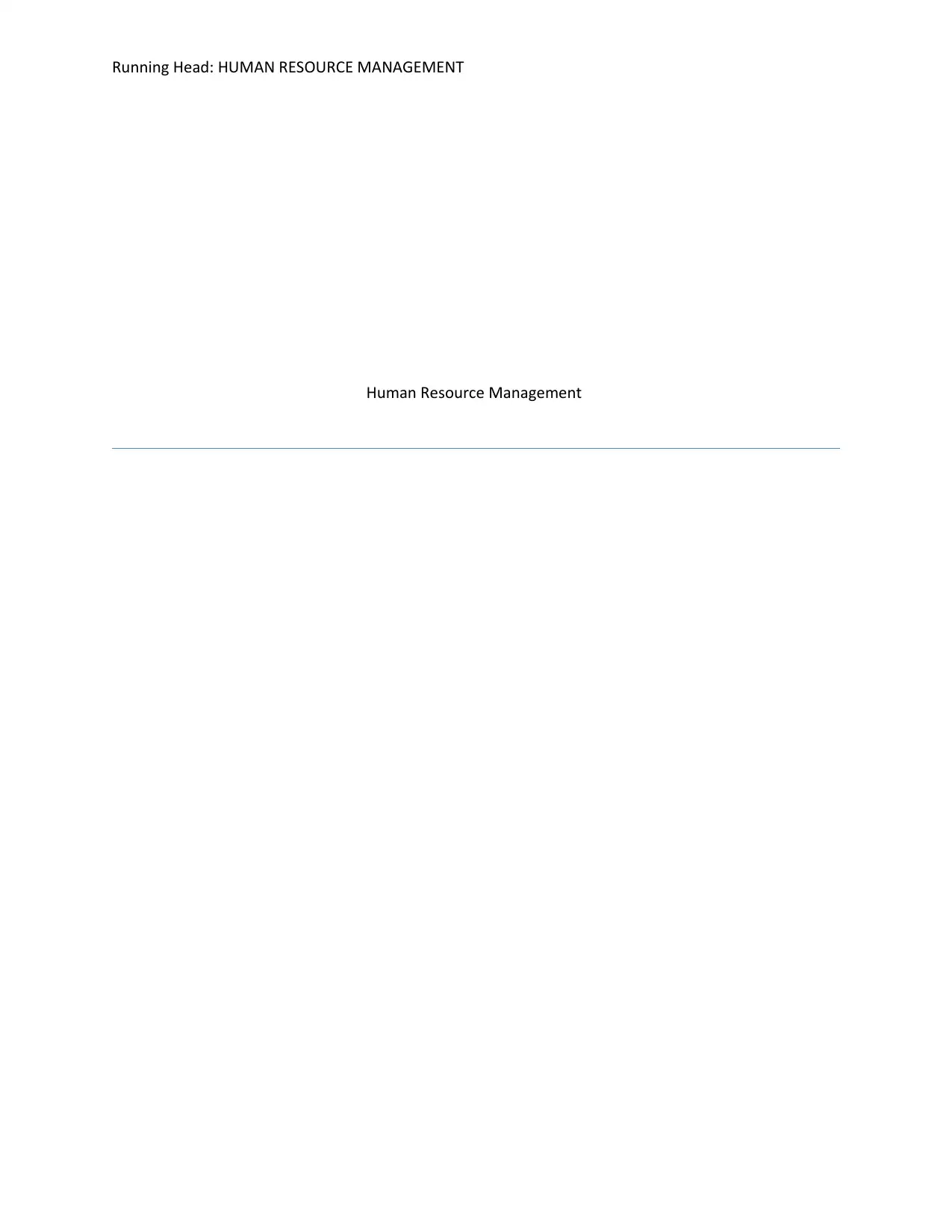
Running Head: HUMAN RESOURCE MANAGEMENT
Human Resource Management
Human Resource Management
Secure Best Marks with AI Grader
Need help grading? Try our AI Grader for instant feedback on your assignments.
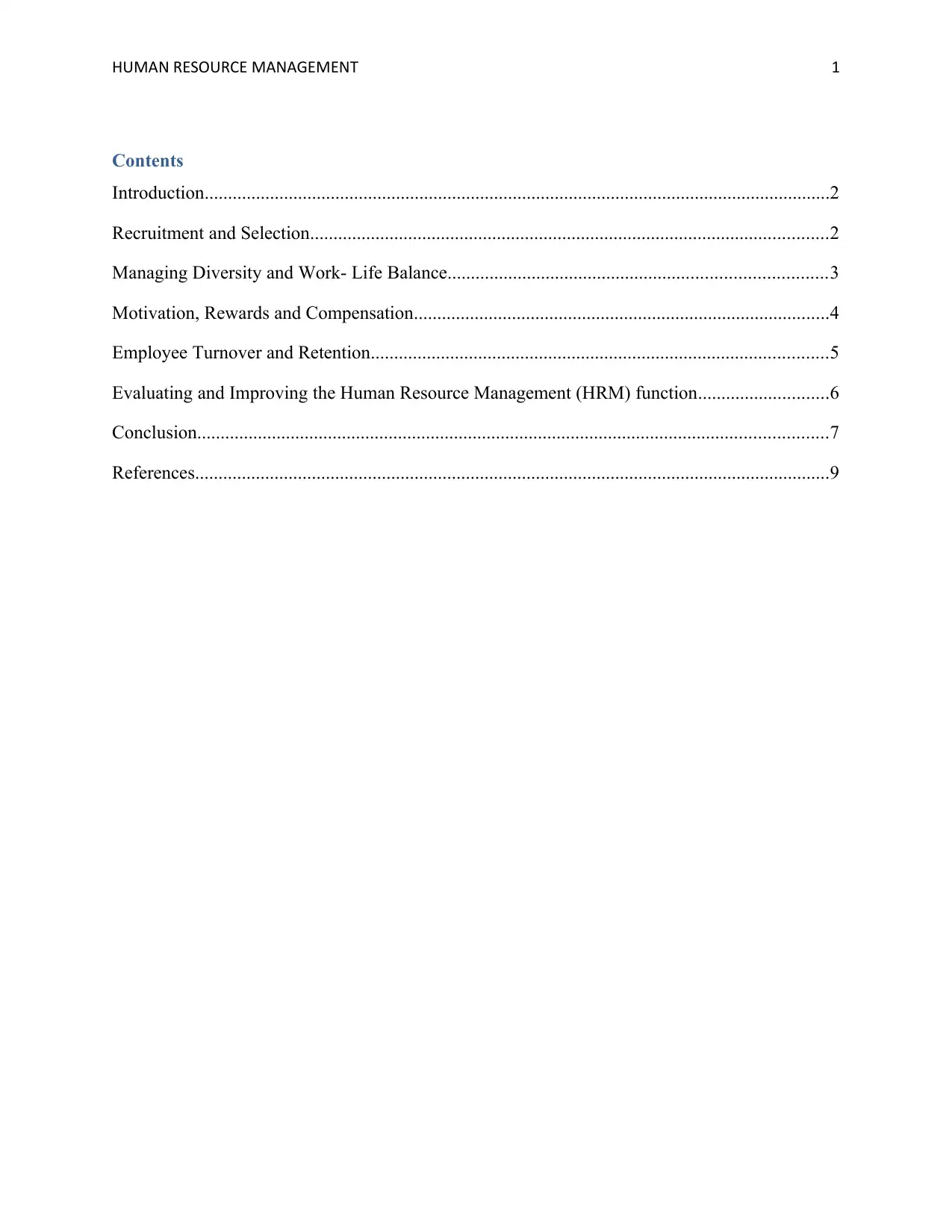
HUMAN RESOURCE MANAGEMENT 1
Contents
Introduction......................................................................................................................................2
Recruitment and Selection...............................................................................................................2
Managing Diversity and Work- Life Balance.................................................................................3
Motivation, Rewards and Compensation.........................................................................................4
Employee Turnover and Retention..................................................................................................5
Evaluating and Improving the Human Resource Management (HRM) function............................6
Conclusion.......................................................................................................................................7
References........................................................................................................................................9
Contents
Introduction......................................................................................................................................2
Recruitment and Selection...............................................................................................................2
Managing Diversity and Work- Life Balance.................................................................................3
Motivation, Rewards and Compensation.........................................................................................4
Employee Turnover and Retention..................................................................................................5
Evaluating and Improving the Human Resource Management (HRM) function............................6
Conclusion.......................................................................................................................................7
References........................................................................................................................................9
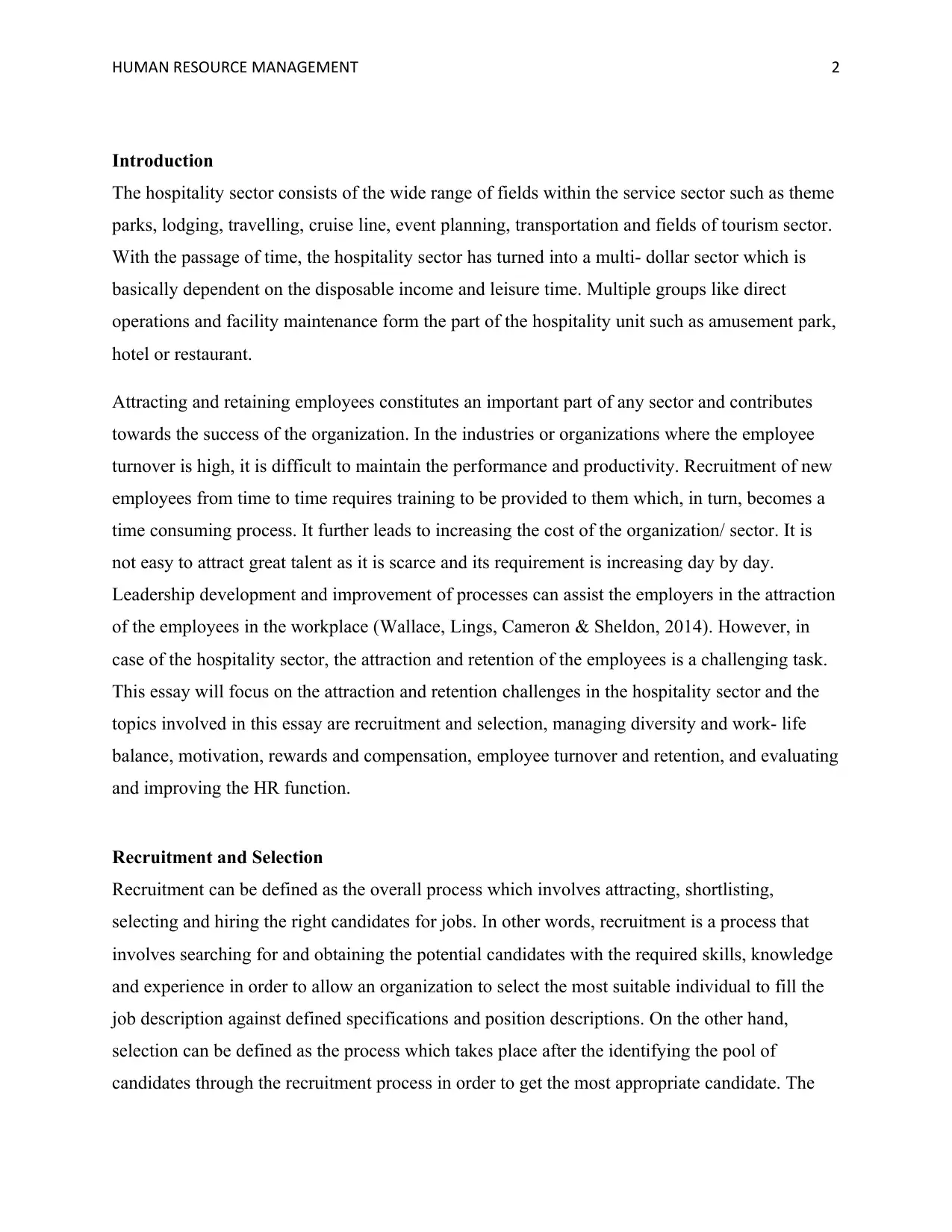
HUMAN RESOURCE MANAGEMENT 2
Introduction
The hospitality sector consists of the wide range of fields within the service sector such as theme
parks, lodging, travelling, cruise line, event planning, transportation and fields of tourism sector.
With the passage of time, the hospitality sector has turned into a multi- dollar sector which is
basically dependent on the disposable income and leisure time. Multiple groups like direct
operations and facility maintenance form the part of the hospitality unit such as amusement park,
hotel or restaurant.
Attracting and retaining employees constitutes an important part of any sector and contributes
towards the success of the organization. In the industries or organizations where the employee
turnover is high, it is difficult to maintain the performance and productivity. Recruitment of new
employees from time to time requires training to be provided to them which, in turn, becomes a
time consuming process. It further leads to increasing the cost of the organization/ sector. It is
not easy to attract great talent as it is scarce and its requirement is increasing day by day.
Leadership development and improvement of processes can assist the employers in the attraction
of the employees in the workplace (Wallace, Lings, Cameron & Sheldon, 2014). However, in
case of the hospitality sector, the attraction and retention of the employees is a challenging task.
This essay will focus on the attraction and retention challenges in the hospitality sector and the
topics involved in this essay are recruitment and selection, managing diversity and work- life
balance, motivation, rewards and compensation, employee turnover and retention, and evaluating
and improving the HR function.
Recruitment and Selection
Recruitment can be defined as the overall process which involves attracting, shortlisting,
selecting and hiring the right candidates for jobs. In other words, recruitment is a process that
involves searching for and obtaining the potential candidates with the required skills, knowledge
and experience in order to allow an organization to select the most suitable individual to fill the
job description against defined specifications and position descriptions. On the other hand,
selection can be defined as the process which takes place after the identifying the pool of
candidates through the recruitment process in order to get the most appropriate candidate. The
Introduction
The hospitality sector consists of the wide range of fields within the service sector such as theme
parks, lodging, travelling, cruise line, event planning, transportation and fields of tourism sector.
With the passage of time, the hospitality sector has turned into a multi- dollar sector which is
basically dependent on the disposable income and leisure time. Multiple groups like direct
operations and facility maintenance form the part of the hospitality unit such as amusement park,
hotel or restaurant.
Attracting and retaining employees constitutes an important part of any sector and contributes
towards the success of the organization. In the industries or organizations where the employee
turnover is high, it is difficult to maintain the performance and productivity. Recruitment of new
employees from time to time requires training to be provided to them which, in turn, becomes a
time consuming process. It further leads to increasing the cost of the organization/ sector. It is
not easy to attract great talent as it is scarce and its requirement is increasing day by day.
Leadership development and improvement of processes can assist the employers in the attraction
of the employees in the workplace (Wallace, Lings, Cameron & Sheldon, 2014). However, in
case of the hospitality sector, the attraction and retention of the employees is a challenging task.
This essay will focus on the attraction and retention challenges in the hospitality sector and the
topics involved in this essay are recruitment and selection, managing diversity and work- life
balance, motivation, rewards and compensation, employee turnover and retention, and evaluating
and improving the HR function.
Recruitment and Selection
Recruitment can be defined as the overall process which involves attracting, shortlisting,
selecting and hiring the right candidates for jobs. In other words, recruitment is a process that
involves searching for and obtaining the potential candidates with the required skills, knowledge
and experience in order to allow an organization to select the most suitable individual to fill the
job description against defined specifications and position descriptions. On the other hand,
selection can be defined as the process which takes place after the identifying the pool of
candidates through the recruitment process in order to get the most appropriate candidate. The
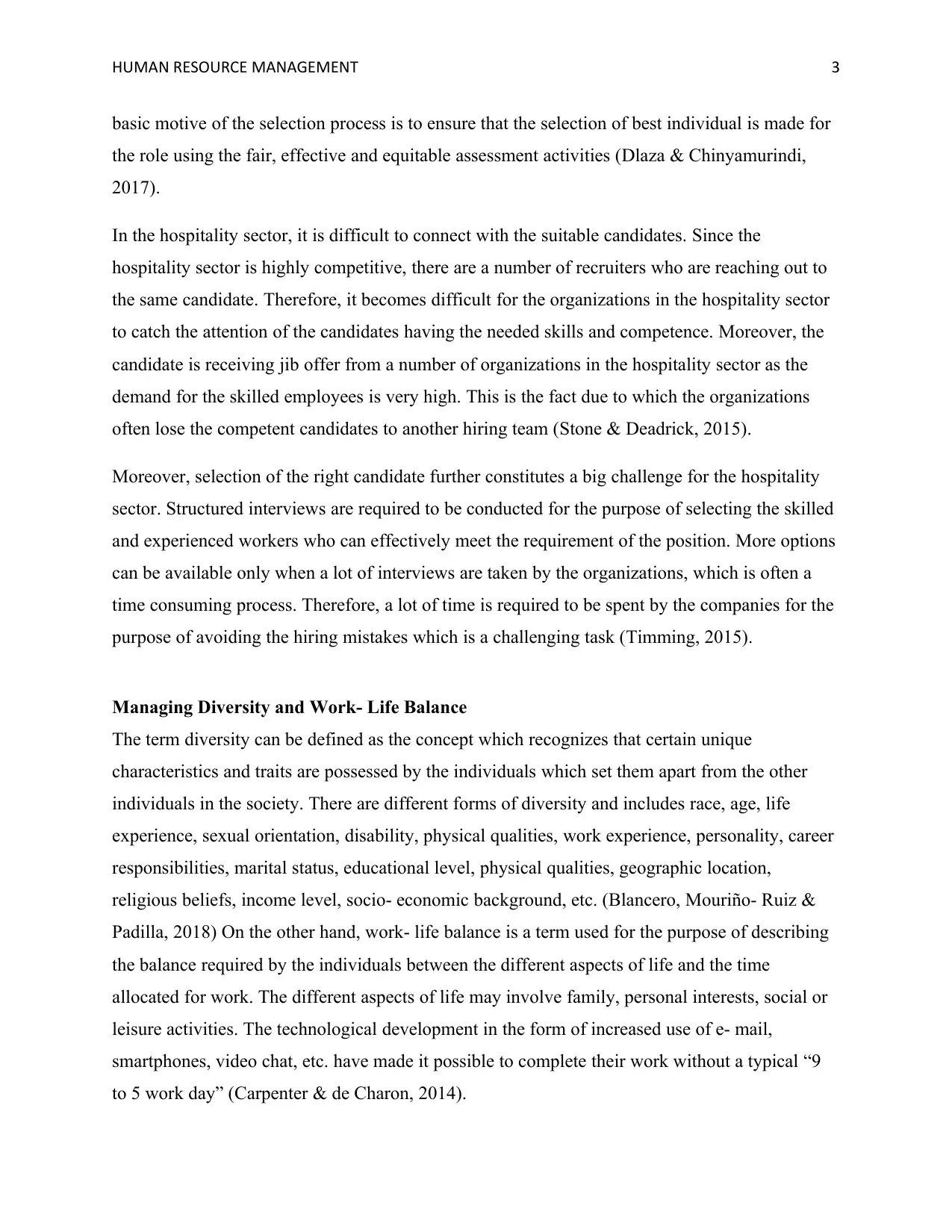
HUMAN RESOURCE MANAGEMENT 3
basic motive of the selection process is to ensure that the selection of best individual is made for
the role using the fair, effective and equitable assessment activities (Dlaza & Chinyamurindi,
2017).
In the hospitality sector, it is difficult to connect with the suitable candidates. Since the
hospitality sector is highly competitive, there are a number of recruiters who are reaching out to
the same candidate. Therefore, it becomes difficult for the organizations in the hospitality sector
to catch the attention of the candidates having the needed skills and competence. Moreover, the
candidate is receiving jib offer from a number of organizations in the hospitality sector as the
demand for the skilled employees is very high. This is the fact due to which the organizations
often lose the competent candidates to another hiring team (Stone & Deadrick, 2015).
Moreover, selection of the right candidate further constitutes a big challenge for the hospitality
sector. Structured interviews are required to be conducted for the purpose of selecting the skilled
and experienced workers who can effectively meet the requirement of the position. More options
can be available only when a lot of interviews are taken by the organizations, which is often a
time consuming process. Therefore, a lot of time is required to be spent by the companies for the
purpose of avoiding the hiring mistakes which is a challenging task (Timming, 2015).
Managing Diversity and Work- Life Balance
The term diversity can be defined as the concept which recognizes that certain unique
characteristics and traits are possessed by the individuals which set them apart from the other
individuals in the society. There are different forms of diversity and includes race, age, life
experience, sexual orientation, disability, physical qualities, work experience, personality, career
responsibilities, marital status, educational level, physical qualities, geographic location,
religious beliefs, income level, socio- economic background, etc. (Blancero, Mouriño- Ruiz &
Padilla, 2018) On the other hand, work- life balance is a term used for the purpose of describing
the balance required by the individuals between the different aspects of life and the time
allocated for work. The different aspects of life may involve family, personal interests, social or
leisure activities. The technological development in the form of increased use of e- mail,
smartphones, video chat, etc. have made it possible to complete their work without a typical “9
to 5 work day” (Carpenter & de Charon, 2014).
basic motive of the selection process is to ensure that the selection of best individual is made for
the role using the fair, effective and equitable assessment activities (Dlaza & Chinyamurindi,
2017).
In the hospitality sector, it is difficult to connect with the suitable candidates. Since the
hospitality sector is highly competitive, there are a number of recruiters who are reaching out to
the same candidate. Therefore, it becomes difficult for the organizations in the hospitality sector
to catch the attention of the candidates having the needed skills and competence. Moreover, the
candidate is receiving jib offer from a number of organizations in the hospitality sector as the
demand for the skilled employees is very high. This is the fact due to which the organizations
often lose the competent candidates to another hiring team (Stone & Deadrick, 2015).
Moreover, selection of the right candidate further constitutes a big challenge for the hospitality
sector. Structured interviews are required to be conducted for the purpose of selecting the skilled
and experienced workers who can effectively meet the requirement of the position. More options
can be available only when a lot of interviews are taken by the organizations, which is often a
time consuming process. Therefore, a lot of time is required to be spent by the companies for the
purpose of avoiding the hiring mistakes which is a challenging task (Timming, 2015).
Managing Diversity and Work- Life Balance
The term diversity can be defined as the concept which recognizes that certain unique
characteristics and traits are possessed by the individuals which set them apart from the other
individuals in the society. There are different forms of diversity and includes race, age, life
experience, sexual orientation, disability, physical qualities, work experience, personality, career
responsibilities, marital status, educational level, physical qualities, geographic location,
religious beliefs, income level, socio- economic background, etc. (Blancero, Mouriño- Ruiz &
Padilla, 2018) On the other hand, work- life balance is a term used for the purpose of describing
the balance required by the individuals between the different aspects of life and the time
allocated for work. The different aspects of life may involve family, personal interests, social or
leisure activities. The technological development in the form of increased use of e- mail,
smartphones, video chat, etc. have made it possible to complete their work without a typical “9
to 5 work day” (Carpenter & de Charon, 2014).
Secure Best Marks with AI Grader
Need help grading? Try our AI Grader for instant feedback on your assignments.
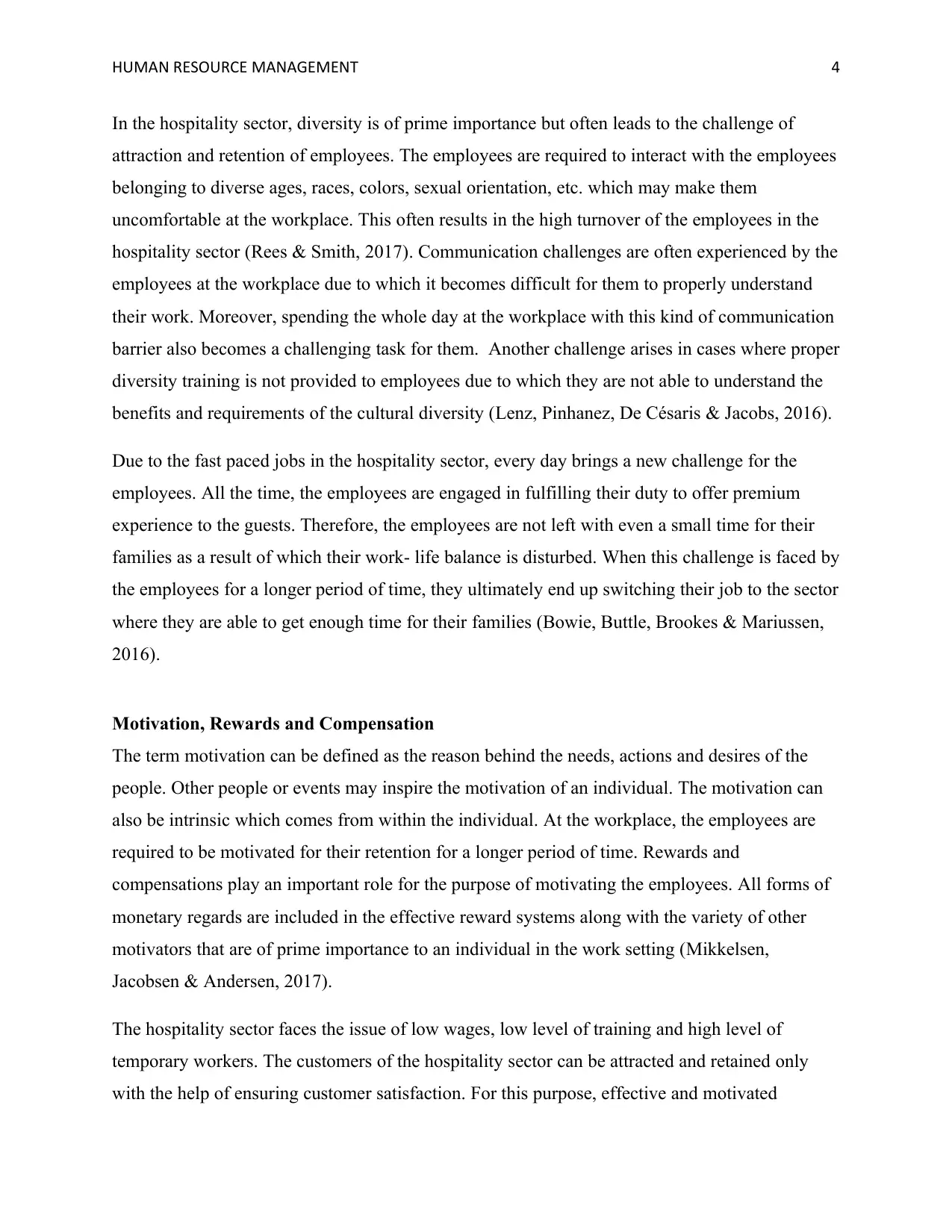
HUMAN RESOURCE MANAGEMENT 4
In the hospitality sector, diversity is of prime importance but often leads to the challenge of
attraction and retention of employees. The employees are required to interact with the employees
belonging to diverse ages, races, colors, sexual orientation, etc. which may make them
uncomfortable at the workplace. This often results in the high turnover of the employees in the
hospitality sector (Rees & Smith, 2017). Communication challenges are often experienced by the
employees at the workplace due to which it becomes difficult for them to properly understand
their work. Moreover, spending the whole day at the workplace with this kind of communication
barrier also becomes a challenging task for them. Another challenge arises in cases where proper
diversity training is not provided to employees due to which they are not able to understand the
benefits and requirements of the cultural diversity (Lenz, Pinhanez, De Césaris & Jacobs, 2016).
Due to the fast paced jobs in the hospitality sector, every day brings a new challenge for the
employees. All the time, the employees are engaged in fulfilling their duty to offer premium
experience to the guests. Therefore, the employees are not left with even a small time for their
families as a result of which their work- life balance is disturbed. When this challenge is faced by
the employees for a longer period of time, they ultimately end up switching their job to the sector
where they are able to get enough time for their families (Bowie, Buttle, Brookes & Mariussen,
2016).
Motivation, Rewards and Compensation
The term motivation can be defined as the reason behind the needs, actions and desires of the
people. Other people or events may inspire the motivation of an individual. The motivation can
also be intrinsic which comes from within the individual. At the workplace, the employees are
required to be motivated for their retention for a longer period of time. Rewards and
compensations play an important role for the purpose of motivating the employees. All forms of
monetary regards are included in the effective reward systems along with the variety of other
motivators that are of prime importance to an individual in the work setting (Mikkelsen,
Jacobsen & Andersen, 2017).
The hospitality sector faces the issue of low wages, low level of training and high level of
temporary workers. The customers of the hospitality sector can be attracted and retained only
with the help of ensuring customer satisfaction. For this purpose, effective and motivated
In the hospitality sector, diversity is of prime importance but often leads to the challenge of
attraction and retention of employees. The employees are required to interact with the employees
belonging to diverse ages, races, colors, sexual orientation, etc. which may make them
uncomfortable at the workplace. This often results in the high turnover of the employees in the
hospitality sector (Rees & Smith, 2017). Communication challenges are often experienced by the
employees at the workplace due to which it becomes difficult for them to properly understand
their work. Moreover, spending the whole day at the workplace with this kind of communication
barrier also becomes a challenging task for them. Another challenge arises in cases where proper
diversity training is not provided to employees due to which they are not able to understand the
benefits and requirements of the cultural diversity (Lenz, Pinhanez, De Césaris & Jacobs, 2016).
Due to the fast paced jobs in the hospitality sector, every day brings a new challenge for the
employees. All the time, the employees are engaged in fulfilling their duty to offer premium
experience to the guests. Therefore, the employees are not left with even a small time for their
families as a result of which their work- life balance is disturbed. When this challenge is faced by
the employees for a longer period of time, they ultimately end up switching their job to the sector
where they are able to get enough time for their families (Bowie, Buttle, Brookes & Mariussen,
2016).
Motivation, Rewards and Compensation
The term motivation can be defined as the reason behind the needs, actions and desires of the
people. Other people or events may inspire the motivation of an individual. The motivation can
also be intrinsic which comes from within the individual. At the workplace, the employees are
required to be motivated for their retention for a longer period of time. Rewards and
compensations play an important role for the purpose of motivating the employees. All forms of
monetary regards are included in the effective reward systems along with the variety of other
motivators that are of prime importance to an individual in the work setting (Mikkelsen,
Jacobsen & Andersen, 2017).
The hospitality sector faces the issue of low wages, low level of training and high level of
temporary workers. The customers of the hospitality sector can be attracted and retained only
with the help of ensuring customer satisfaction. For this purpose, effective and motivated
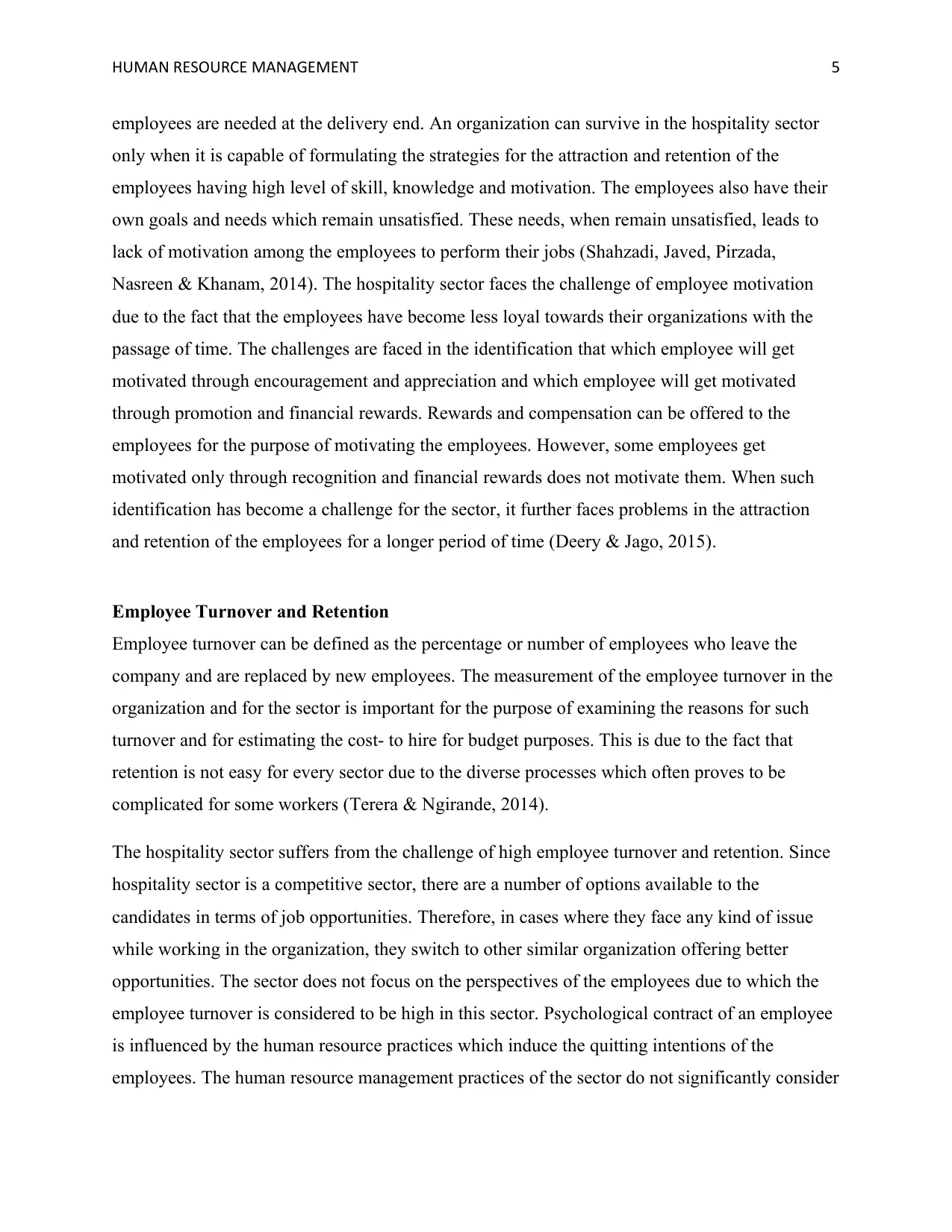
HUMAN RESOURCE MANAGEMENT 5
employees are needed at the delivery end. An organization can survive in the hospitality sector
only when it is capable of formulating the strategies for the attraction and retention of the
employees having high level of skill, knowledge and motivation. The employees also have their
own goals and needs which remain unsatisfied. These needs, when remain unsatisfied, leads to
lack of motivation among the employees to perform their jobs (Shahzadi, Javed, Pirzada,
Nasreen & Khanam, 2014). The hospitality sector faces the challenge of employee motivation
due to the fact that the employees have become less loyal towards their organizations with the
passage of time. The challenges are faced in the identification that which employee will get
motivated through encouragement and appreciation and which employee will get motivated
through promotion and financial rewards. Rewards and compensation can be offered to the
employees for the purpose of motivating the employees. However, some employees get
motivated only through recognition and financial rewards does not motivate them. When such
identification has become a challenge for the sector, it further faces problems in the attraction
and retention of the employees for a longer period of time (Deery & Jago, 2015).
Employee Turnover and Retention
Employee turnover can be defined as the percentage or number of employees who leave the
company and are replaced by new employees. The measurement of the employee turnover in the
organization and for the sector is important for the purpose of examining the reasons for such
turnover and for estimating the cost- to hire for budget purposes. This is due to the fact that
retention is not easy for every sector due to the diverse processes which often proves to be
complicated for some workers (Terera & Ngirande, 2014).
The hospitality sector suffers from the challenge of high employee turnover and retention. Since
hospitality sector is a competitive sector, there are a number of options available to the
candidates in terms of job opportunities. Therefore, in cases where they face any kind of issue
while working in the organization, they switch to other similar organization offering better
opportunities. The sector does not focus on the perspectives of the employees due to which the
employee turnover is considered to be high in this sector. Psychological contract of an employee
is influenced by the human resource practices which induce the quitting intentions of the
employees. The human resource management practices of the sector do not significantly consider
employees are needed at the delivery end. An organization can survive in the hospitality sector
only when it is capable of formulating the strategies for the attraction and retention of the
employees having high level of skill, knowledge and motivation. The employees also have their
own goals and needs which remain unsatisfied. These needs, when remain unsatisfied, leads to
lack of motivation among the employees to perform their jobs (Shahzadi, Javed, Pirzada,
Nasreen & Khanam, 2014). The hospitality sector faces the challenge of employee motivation
due to the fact that the employees have become less loyal towards their organizations with the
passage of time. The challenges are faced in the identification that which employee will get
motivated through encouragement and appreciation and which employee will get motivated
through promotion and financial rewards. Rewards and compensation can be offered to the
employees for the purpose of motivating the employees. However, some employees get
motivated only through recognition and financial rewards does not motivate them. When such
identification has become a challenge for the sector, it further faces problems in the attraction
and retention of the employees for a longer period of time (Deery & Jago, 2015).
Employee Turnover and Retention
Employee turnover can be defined as the percentage or number of employees who leave the
company and are replaced by new employees. The measurement of the employee turnover in the
organization and for the sector is important for the purpose of examining the reasons for such
turnover and for estimating the cost- to hire for budget purposes. This is due to the fact that
retention is not easy for every sector due to the diverse processes which often proves to be
complicated for some workers (Terera & Ngirande, 2014).
The hospitality sector suffers from the challenge of high employee turnover and retention. Since
hospitality sector is a competitive sector, there are a number of options available to the
candidates in terms of job opportunities. Therefore, in cases where they face any kind of issue
while working in the organization, they switch to other similar organization offering better
opportunities. The sector does not focus on the perspectives of the employees due to which the
employee turnover is considered to be high in this sector. Psychological contract of an employee
is influenced by the human resource practices which induce the quitting intentions of the
employees. The human resource management practices of the sector do not significantly consider
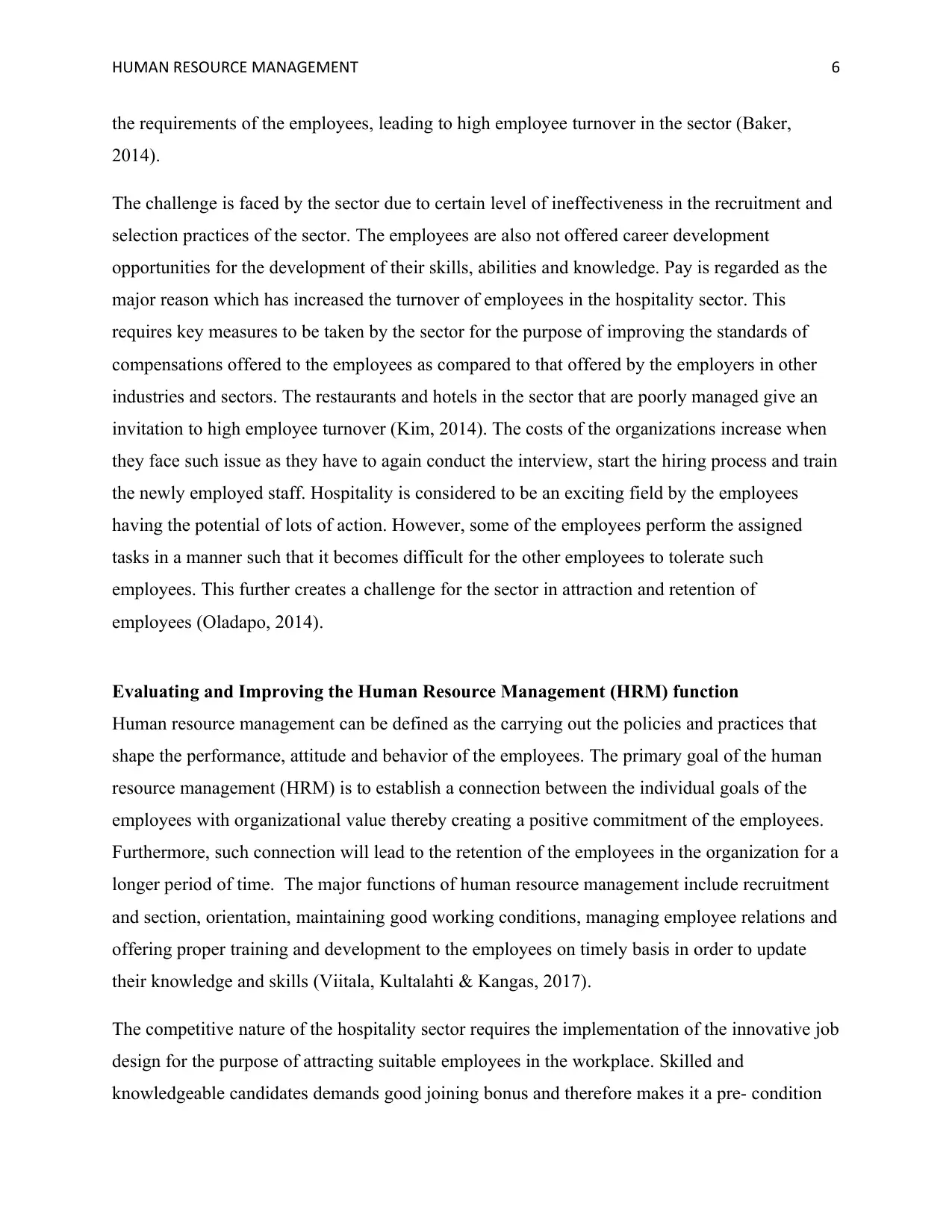
HUMAN RESOURCE MANAGEMENT 6
the requirements of the employees, leading to high employee turnover in the sector (Baker,
2014).
The challenge is faced by the sector due to certain level of ineffectiveness in the recruitment and
selection practices of the sector. The employees are also not offered career development
opportunities for the development of their skills, abilities and knowledge. Pay is regarded as the
major reason which has increased the turnover of employees in the hospitality sector. This
requires key measures to be taken by the sector for the purpose of improving the standards of
compensations offered to the employees as compared to that offered by the employers in other
industries and sectors. The restaurants and hotels in the sector that are poorly managed give an
invitation to high employee turnover (Kim, 2014). The costs of the organizations increase when
they face such issue as they have to again conduct the interview, start the hiring process and train
the newly employed staff. Hospitality is considered to be an exciting field by the employees
having the potential of lots of action. However, some of the employees perform the assigned
tasks in a manner such that it becomes difficult for the other employees to tolerate such
employees. This further creates a challenge for the sector in attraction and retention of
employees (Oladapo, 2014).
Evaluating and Improving the Human Resource Management (HRM) function
Human resource management can be defined as the carrying out the policies and practices that
shape the performance, attitude and behavior of the employees. The primary goal of the human
resource management (HRM) is to establish a connection between the individual goals of the
employees with organizational value thereby creating a positive commitment of the employees.
Furthermore, such connection will lead to the retention of the employees in the organization for a
longer period of time. The major functions of human resource management include recruitment
and section, orientation, maintaining good working conditions, managing employee relations and
offering proper training and development to the employees on timely basis in order to update
their knowledge and skills (Viitala, Kultalahti & Kangas, 2017).
The competitive nature of the hospitality sector requires the implementation of the innovative job
design for the purpose of attracting suitable employees in the workplace. Skilled and
knowledgeable candidates demands good joining bonus and therefore makes it a pre- condition
the requirements of the employees, leading to high employee turnover in the sector (Baker,
2014).
The challenge is faced by the sector due to certain level of ineffectiveness in the recruitment and
selection practices of the sector. The employees are also not offered career development
opportunities for the development of their skills, abilities and knowledge. Pay is regarded as the
major reason which has increased the turnover of employees in the hospitality sector. This
requires key measures to be taken by the sector for the purpose of improving the standards of
compensations offered to the employees as compared to that offered by the employers in other
industries and sectors. The restaurants and hotels in the sector that are poorly managed give an
invitation to high employee turnover (Kim, 2014). The costs of the organizations increase when
they face such issue as they have to again conduct the interview, start the hiring process and train
the newly employed staff. Hospitality is considered to be an exciting field by the employees
having the potential of lots of action. However, some of the employees perform the assigned
tasks in a manner such that it becomes difficult for the other employees to tolerate such
employees. This further creates a challenge for the sector in attraction and retention of
employees (Oladapo, 2014).
Evaluating and Improving the Human Resource Management (HRM) function
Human resource management can be defined as the carrying out the policies and practices that
shape the performance, attitude and behavior of the employees. The primary goal of the human
resource management (HRM) is to establish a connection between the individual goals of the
employees with organizational value thereby creating a positive commitment of the employees.
Furthermore, such connection will lead to the retention of the employees in the organization for a
longer period of time. The major functions of human resource management include recruitment
and section, orientation, maintaining good working conditions, managing employee relations and
offering proper training and development to the employees on timely basis in order to update
their knowledge and skills (Viitala, Kultalahti & Kangas, 2017).
The competitive nature of the hospitality sector requires the implementation of the innovative job
design for the purpose of attracting suitable employees in the workplace. Skilled and
knowledgeable candidates demands good joining bonus and therefore makes it a pre- condition
Paraphrase This Document
Need a fresh take? Get an instant paraphrase of this document with our AI Paraphraser

HUMAN RESOURCE MANAGEMENT 7
for hiring such employees. Safe and healthy environment is another challenge required to be
provided to the employees in the hospitality sector. Moreover, since this sector faces the problem
of high employee turnover, the retention of the employees is the major problem faced by the HR
managers. When the employees are required to be replaced from time to time, the expenses
increase along with the requirement of providing them training (Sumner & Brown, 2015).
Employees working in the hospitality industry find themselves unsafe at various points of time.
Therefore, the hospitality sector faces the challenge of attraction and retention of employees as
there are no safety rules in the organizations which are required to be strictly followed. There are
also a number of chances for injuries in the sector in the kitchen, on ladders, cleaning chemicals,
with breaking glass, etc. The lack of consideration of the safety rules in the hospitality sector
creates a challenge in attracting and retaining employees in the sector. All these factors act as a
challenge of the hospitality industry in attracting and retaining the employees (Rathi & Lee,
2015).
Conclusion
Therefore, it can be concluded that attracting and retaining employees constitutes an important
part of any sector and contributes towards the success of the organization. Hospitality sector
consists of the wide range of fields within the service sector such as theme parks, lodging,
travelling, cruise line, event planning, transportation and fields of tourism sector. This essay
focused on the attraction and retention challenges in the hospitality sector and the topics involved
in this essay were recruitment and selection, managing diversity and work- life balance,
motivation, rewards and compensation, employee turnover and retention, and evaluating and
improving the HR function (Montague, Burgess & Connell, 2015).
In the hospitality sector, it is difficult to connect with the suitable candidates. Since the
hospitality sector is highly competitive, there are a number of recruiters who are reaching out to
the same candidate. Due to the fast paced jobs in the hospitality sector, every day brings a new
challenge for the employees. The employees are not left with even a small time for their families
as a result of which their work- life balance is disturbed. The challenges are also faced in terms
of motivating the employees through financial rewards and compensation. Furthermore, the
employee retention of the sector is also very high and pay is considered as the major factor
for hiring such employees. Safe and healthy environment is another challenge required to be
provided to the employees in the hospitality sector. Moreover, since this sector faces the problem
of high employee turnover, the retention of the employees is the major problem faced by the HR
managers. When the employees are required to be replaced from time to time, the expenses
increase along with the requirement of providing them training (Sumner & Brown, 2015).
Employees working in the hospitality industry find themselves unsafe at various points of time.
Therefore, the hospitality sector faces the challenge of attraction and retention of employees as
there are no safety rules in the organizations which are required to be strictly followed. There are
also a number of chances for injuries in the sector in the kitchen, on ladders, cleaning chemicals,
with breaking glass, etc. The lack of consideration of the safety rules in the hospitality sector
creates a challenge in attracting and retaining employees in the sector. All these factors act as a
challenge of the hospitality industry in attracting and retaining the employees (Rathi & Lee,
2015).
Conclusion
Therefore, it can be concluded that attracting and retaining employees constitutes an important
part of any sector and contributes towards the success of the organization. Hospitality sector
consists of the wide range of fields within the service sector such as theme parks, lodging,
travelling, cruise line, event planning, transportation and fields of tourism sector. This essay
focused on the attraction and retention challenges in the hospitality sector and the topics involved
in this essay were recruitment and selection, managing diversity and work- life balance,
motivation, rewards and compensation, employee turnover and retention, and evaluating and
improving the HR function (Montague, Burgess & Connell, 2015).
In the hospitality sector, it is difficult to connect with the suitable candidates. Since the
hospitality sector is highly competitive, there are a number of recruiters who are reaching out to
the same candidate. Due to the fast paced jobs in the hospitality sector, every day brings a new
challenge for the employees. The employees are not left with even a small time for their families
as a result of which their work- life balance is disturbed. The challenges are also faced in terms
of motivating the employees through financial rewards and compensation. Furthermore, the
employee retention of the sector is also very high and pay is considered as the major factor
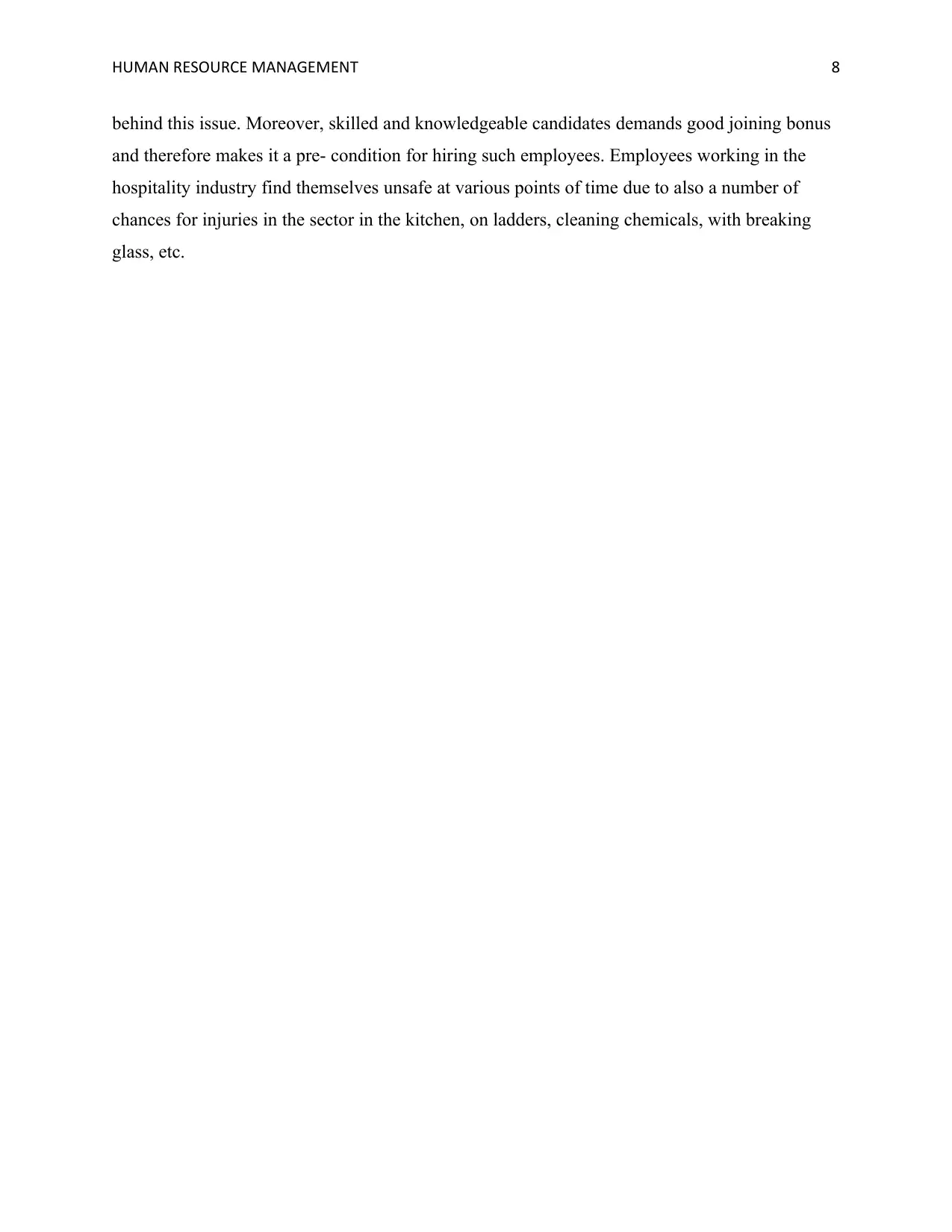
HUMAN RESOURCE MANAGEMENT 8
behind this issue. Moreover, skilled and knowledgeable candidates demands good joining bonus
and therefore makes it a pre- condition for hiring such employees. Employees working in the
hospitality industry find themselves unsafe at various points of time due to also a number of
chances for injuries in the sector in the kitchen, on ladders, cleaning chemicals, with breaking
glass, etc.
behind this issue. Moreover, skilled and knowledgeable candidates demands good joining bonus
and therefore makes it a pre- condition for hiring such employees. Employees working in the
hospitality industry find themselves unsafe at various points of time due to also a number of
chances for injuries in the sector in the kitchen, on ladders, cleaning chemicals, with breaking
glass, etc.

HUMAN RESOURCE MANAGEMENT 9
References
Baker, T. (2014). Attracting and retaining talent: Becoming an employer of choice. Springer.
Blancero, D. M., Mouriño-Ruiz, E., & Padilla, A. M. (2018). Latino Millennials—The New
Diverse Workforce: Challenges and Opportunities. Hispanic Journal of Behavioral
Sciences, 40(1), 3-21.
Bowie, D., Buttle, F., Brookes, M., & Mariussen, A. (2016). Hospitality marketing. Routledge.
Carpenter, M. J., & de Charon, L. C. (2014). Mitigating multigenerational conflict and attracting,
motivating, and retaining millennial employees by changing the organizational culture: A
theoretical model. Journal of Psychological Issues in Organizational Culture, 5(3), 68-
84.
Deery, M., & Jago, L. (2015). Revisiting talent management, work-life balance and retention
strategies. International Journal of Contemporary Hospitality Management, 27(3), 453-
472.
Dlaza, Z., & Chinyamurindi, W. T. (2017). Social media within the context of human resource
management-Social media in employee selection and recruitment: theory, practice and
current challenges, Richard N. Landers, Gordon B. Schmidt. SA Journal of Human
Resource Management, 15(1), 1-2.
Kim, N. (2014). Employee turnover intention among newcomers in travel industry. International
Journal of Tourism Research, 16(1), 56-64.
Lenz, S., Pinhanez, M., De Césaris, L. E. U., & Jacobs, C. (2016). Open innovation and the
challenges of human resource management. International Journal of Innovation
Management, 20(07), 1650063.
Mikkelsen, M. F., Jacobsen, C. B., & Andersen, L. B. (2017). Managing employee motivation:
Exploring the connections between managers’ enforcement actions, employee
perceptions, and employee intrinsic motivation. International Public Management
Journal, 20(2), 183-205.
References
Baker, T. (2014). Attracting and retaining talent: Becoming an employer of choice. Springer.
Blancero, D. M., Mouriño-Ruiz, E., & Padilla, A. M. (2018). Latino Millennials—The New
Diverse Workforce: Challenges and Opportunities. Hispanic Journal of Behavioral
Sciences, 40(1), 3-21.
Bowie, D., Buttle, F., Brookes, M., & Mariussen, A. (2016). Hospitality marketing. Routledge.
Carpenter, M. J., & de Charon, L. C. (2014). Mitigating multigenerational conflict and attracting,
motivating, and retaining millennial employees by changing the organizational culture: A
theoretical model. Journal of Psychological Issues in Organizational Culture, 5(3), 68-
84.
Deery, M., & Jago, L. (2015). Revisiting talent management, work-life balance and retention
strategies. International Journal of Contemporary Hospitality Management, 27(3), 453-
472.
Dlaza, Z., & Chinyamurindi, W. T. (2017). Social media within the context of human resource
management-Social media in employee selection and recruitment: theory, practice and
current challenges, Richard N. Landers, Gordon B. Schmidt. SA Journal of Human
Resource Management, 15(1), 1-2.
Kim, N. (2014). Employee turnover intention among newcomers in travel industry. International
Journal of Tourism Research, 16(1), 56-64.
Lenz, S., Pinhanez, M., De Césaris, L. E. U., & Jacobs, C. (2016). Open innovation and the
challenges of human resource management. International Journal of Innovation
Management, 20(07), 1650063.
Mikkelsen, M. F., Jacobsen, C. B., & Andersen, L. B. (2017). Managing employee motivation:
Exploring the connections between managers’ enforcement actions, employee
perceptions, and employee intrinsic motivation. International Public Management
Journal, 20(2), 183-205.
Secure Best Marks with AI Grader
Need help grading? Try our AI Grader for instant feedback on your assignments.
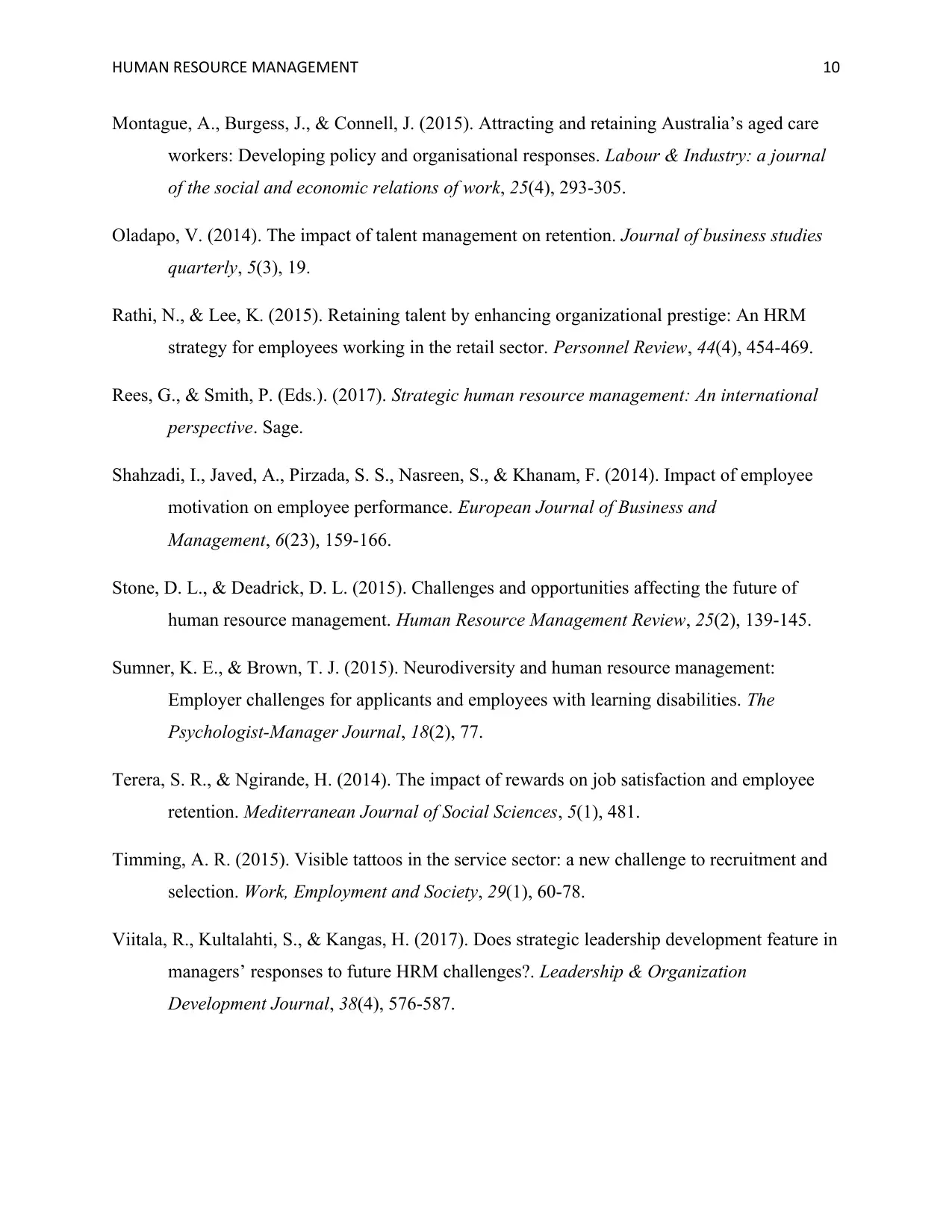
HUMAN RESOURCE MANAGEMENT 10
Montague, A., Burgess, J., & Connell, J. (2015). Attracting and retaining Australia’s aged care
workers: Developing policy and organisational responses. Labour & Industry: a journal
of the social and economic relations of work, 25(4), 293-305.
Oladapo, V. (2014). The impact of talent management on retention. Journal of business studies
quarterly, 5(3), 19.
Rathi, N., & Lee, K. (2015). Retaining talent by enhancing organizational prestige: An HRM
strategy for employees working in the retail sector. Personnel Review, 44(4), 454-469.
Rees, G., & Smith, P. (Eds.). (2017). Strategic human resource management: An international
perspective. Sage.
Shahzadi, I., Javed, A., Pirzada, S. S., Nasreen, S., & Khanam, F. (2014). Impact of employee
motivation on employee performance. European Journal of Business and
Management, 6(23), 159-166.
Stone, D. L., & Deadrick, D. L. (2015). Challenges and opportunities affecting the future of
human resource management. Human Resource Management Review, 25(2), 139-145.
Sumner, K. E., & Brown, T. J. (2015). Neurodiversity and human resource management:
Employer challenges for applicants and employees with learning disabilities. The
Psychologist-Manager Journal, 18(2), 77.
Terera, S. R., & Ngirande, H. (2014). The impact of rewards on job satisfaction and employee
retention. Mediterranean Journal of Social Sciences, 5(1), 481.
Timming, A. R. (2015). Visible tattoos in the service sector: a new challenge to recruitment and
selection. Work, Employment and Society, 29(1), 60-78.
Viitala, R., Kultalahti, S., & Kangas, H. (2017). Does strategic leadership development feature in
managers’ responses to future HRM challenges?. Leadership & Organization
Development Journal, 38(4), 576-587.
Montague, A., Burgess, J., & Connell, J. (2015). Attracting and retaining Australia’s aged care
workers: Developing policy and organisational responses. Labour & Industry: a journal
of the social and economic relations of work, 25(4), 293-305.
Oladapo, V. (2014). The impact of talent management on retention. Journal of business studies
quarterly, 5(3), 19.
Rathi, N., & Lee, K. (2015). Retaining talent by enhancing organizational prestige: An HRM
strategy for employees working in the retail sector. Personnel Review, 44(4), 454-469.
Rees, G., & Smith, P. (Eds.). (2017). Strategic human resource management: An international
perspective. Sage.
Shahzadi, I., Javed, A., Pirzada, S. S., Nasreen, S., & Khanam, F. (2014). Impact of employee
motivation on employee performance. European Journal of Business and
Management, 6(23), 159-166.
Stone, D. L., & Deadrick, D. L. (2015). Challenges and opportunities affecting the future of
human resource management. Human Resource Management Review, 25(2), 139-145.
Sumner, K. E., & Brown, T. J. (2015). Neurodiversity and human resource management:
Employer challenges for applicants and employees with learning disabilities. The
Psychologist-Manager Journal, 18(2), 77.
Terera, S. R., & Ngirande, H. (2014). The impact of rewards on job satisfaction and employee
retention. Mediterranean Journal of Social Sciences, 5(1), 481.
Timming, A. R. (2015). Visible tattoos in the service sector: a new challenge to recruitment and
selection. Work, Employment and Society, 29(1), 60-78.
Viitala, R., Kultalahti, S., & Kangas, H. (2017). Does strategic leadership development feature in
managers’ responses to future HRM challenges?. Leadership & Organization
Development Journal, 38(4), 576-587.
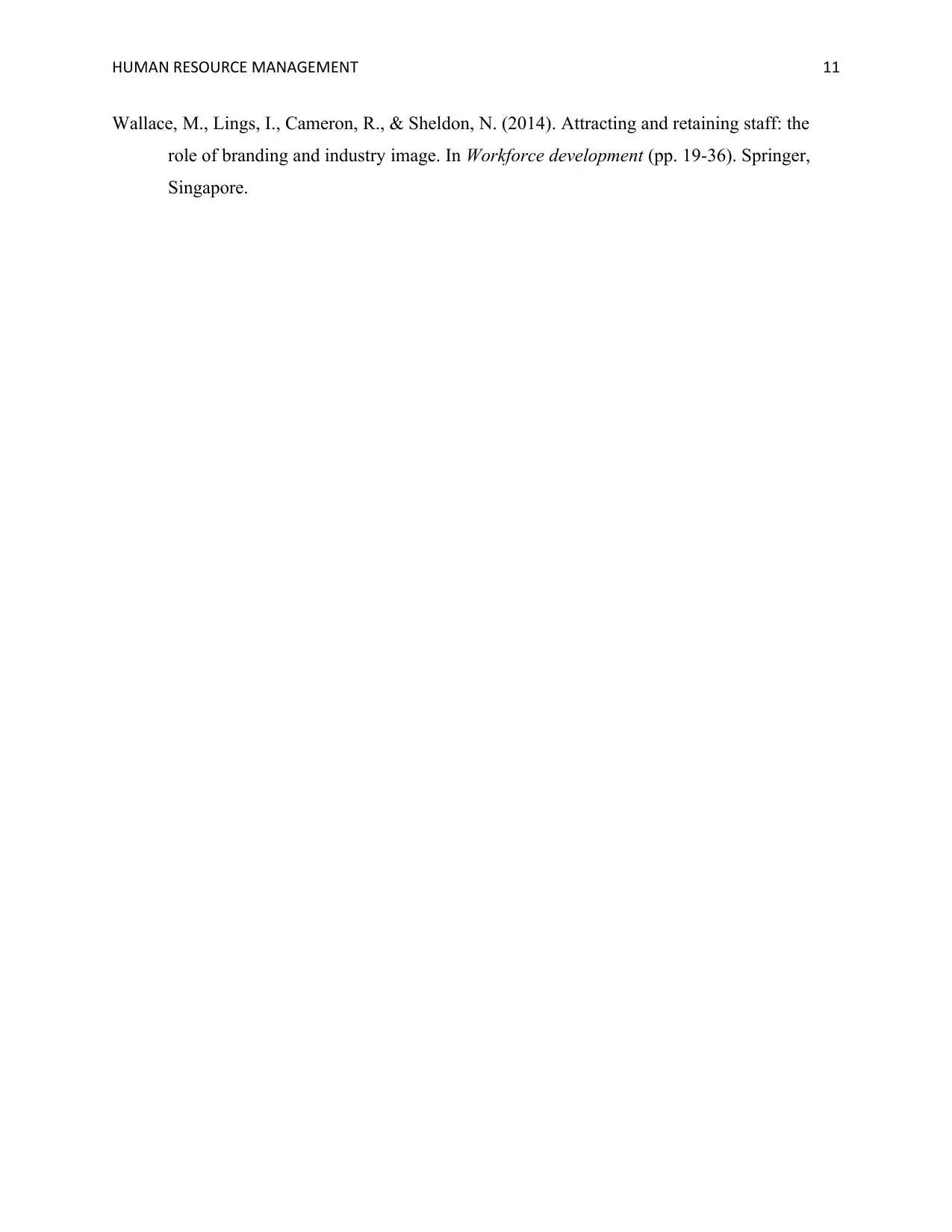
HUMAN RESOURCE MANAGEMENT 11
Wallace, M., Lings, I., Cameron, R., & Sheldon, N. (2014). Attracting and retaining staff: the
role of branding and industry image. In Workforce development (pp. 19-36). Springer,
Singapore.
Wallace, M., Lings, I., Cameron, R., & Sheldon, N. (2014). Attracting and retaining staff: the
role of branding and industry image. In Workforce development (pp. 19-36). Springer,
Singapore.
1 out of 12
Related Documents
Your All-in-One AI-Powered Toolkit for Academic Success.
+13062052269
info@desklib.com
Available 24*7 on WhatsApp / Email
![[object Object]](/_next/static/media/star-bottom.7253800d.svg)
Unlock your academic potential
© 2024 | Zucol Services PVT LTD | All rights reserved.





